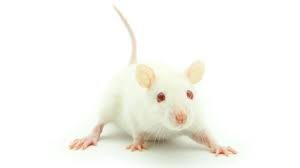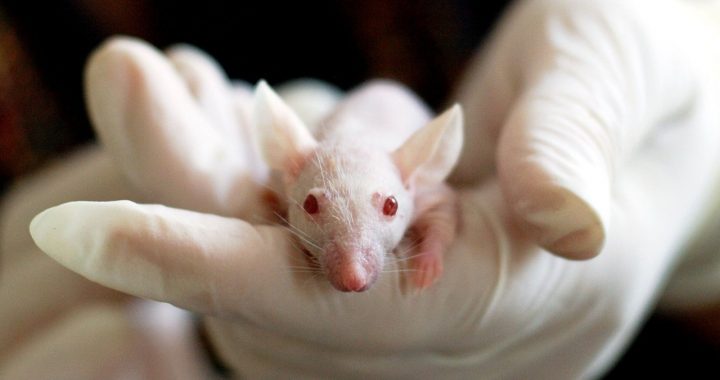
http://articles.latimes.com/
SCIENCE FILE
Of Mice and Mayhem
The Fierce Tempers of Mutant Rodents Born With Their Brains Awash in the Chemical Serotonin May Provide a Clue to Violent Behavior Among Humans
June 06, 1996|TERENCE MONMANEY | TIMES MEDICAL WRITER
The scientist grabs Mutant #9 by the tail, lifts the mouse out of its shoebox-size cage, and lowers it gently into another, identical container, the reeking, sawdust-floored home of Mutant #4.
Blind and jittery, the mice are freaks of nature, products of a genetic engineering experiment that did not go exactly as planned. But, oddly, their encounter in this fifth-floor laboratory at the USC School of Pharmacy may reveal something vital about human nature.
They square off, sniffing furiously, then inch closer. Within seconds, #9 corners #4. And then they dive at each another–a rolling, squeaking, clawing gray blur. Sawdust and fur fly.
Jean Chen Shih, a USC biochemist and promoter of this unlikely murine bout, jumps back, startled by the attack even though she was expecting it. “Normal mice fight also, but not so rapidly as these,” Shih says.
By any measure, the mice, called Tg8, are among the most aggressive in captivity.
This odd little spectacle is part of the quest for answers to the violence clawing at American’s soul. A Tg8 is born with its brain awash in an excess of serotonin, a neurotransmitter chemical that helps regulate mood and mental health, and Shih and her co-workers believe that that excess greatly contributes to the mouse’s fierce temper.
To be sure, a brawl between blind mice in an ivory tower is a far cry from the mayhem and brutality perfected by such brainy animals as ourselves. But the work does appear to touch on human experience: The Tg8’s cardinal biochemical defect was originally discovered in numerous related Dutchmen who committed arson, attempted rape and assault.
The Tg8 mice are the first laboratory animals to share both the biochemical defect and the behavior observed in a pedigree of violent criminals. In that sense, the mice are an important new tool for probing the physiology of running amok. By studying the mice’s trigger-happy biology, researchers hope to understand aggression better and perhaps develop new drugs that control it.
But for every potential new use of such information, critics envision a new abuse. Steven Rose, a biologist at the Open University in England, is an outspoken critic of the idea that one’s genetic makeup determines behavior–a scientific premise he calls “neurogenetic determinism.”
Sociologist Dorothy Nelkin of New York University says that conservatives might seize on biological explanations of violence to “dismantle the welfare state,” because controlling aggression with drugs could well be much cheaper than rehabilitation programs.
She also fears that if certain biochemical signatures became associated with violence or criminal behavior, people with such a makeup could be wrongly implicated and stigmatized as potential threats to society–the physiological equivalent of a bad credit rating. The Tg8 research and similar studies, she says, “open up a whole set of problems that are worthy of careful consideration.”
No such heady dilemmas weighed upon scientists at the Pasteur Institute near Paris when they accidentally created the Tg8 mouse strain two years ago. Olivier Cases and colleagues were trying to develop a novel gene therapy by injecting a one-celled embryo of a special lab strain of blind mice with a shred of foreign DNA. But instead of resulting in a “new” mouse pup with a bolstered immune system, the experiment led to a strain of male mice with a really bad temper.
The first indicator of that ill nature was painfully obvious: The mice nipped the researchers’ fingers. When caged together, male Tg8s–the Tg is for “transgenic”–tore each other apart. And the researchers also found that when male and female mice mated, the males were especially quick, grabby and forceful, eliciting more female squeaks, on average, than other males did.
Those traits may be reminiscent of any number of men, but the French researchers were put in mind of certain Dutch males in one extended family described in the medical literature. Over four generations, a remarkable number of those males were accused or convicted of rape, assault and arson, leading local psychologists as well as law enforcement authorities to watch them very closely.
After much study, Dutch scientists reported a finding in 1993 that, they believed, helped explain the aggressive males’ behavior: They were missing an enzyme called monoamine oxidase A, or MAO-A, which breaks down a variety of neurotransmitters, including serotonin. Lacking the MAO-A enzyme, the affected males, who also had borderline mental retardation, had extra-high levels of several neurotransmitters, including serotonin.
The genetic defect found in the violent Dutchmen is probably very rare, researchers say, and certainly doesn’t account for what makes most aggressive people act that way. Still, the finding offers a unique window into how disruptions in brain chemistry can be correlated with a pattern of antisocial behavior.
Given the Dutch findings, then, it was logical for the sore-fingered French researchers to want to know if their mutant mice also lacked the MAO enzyme. That’s where Shih, a world expert on that family of enzymes, came in. Not long after she agreed to test the Tg8 mice for the enzyme, a shipment of the creatures arrived from France (having spent weeks in quarantine at Los Angeles International Airport).
It took Shih and her co-workers several months of painstaking lab work to establish that the male mice were indeed lacking the gene for the MAO-A enzyme–just like the affected Dutchmen. “When this gene is missing, the animals are very aggressive and hyperactive,” Shih says.
Her Tg8 study, says Randy Nelson, a behavioral psychologist at Johns Hopkins University, was “one of the first to show a biological mechanism for aggressive behavior in an animal.” Follow-up studies published this spring in the journal Neuron suggest that the neurotransmitter defect actually affects the structure of the Tg8’s brain, most likely by skewing growth and development in fetal and newborn mice.
Nelson says it’s no surprise that genes affect temperament. “Anybody who knows the difference between a pit bull and a Labrador retriever knows that aggressive behavior has a genetic basis,” he says.
Some researchers expect that the biochemical analysis of behavior will pay off. Dr. Frederick Moeller, a psychiatrist at the University of Texas in Houston, hopes that the missing-enzyme research leads to new drugs for treating criminals and other violent people who simply can’t control their aggression. “I treat individuals who . . . can’t keep from assaulting hospital staff even long enough to get out of the hospital,” he says.
“The goal isn’t to control everybody and make them less aggressive,” he says. “The goal is to work with real people who have a real problem with aggression.”
For her part, Shih is a little dismayed to find herself in the middle of such a hot controversy. “I like to avoid the political issues,” the biochemist says.
Even though she is no sociologist, Shih believes that she can make a contribution to understanding human behavior by studying the Tg8’s biology.
That possibility is apparent to her whenever she returns the mice to their cages in the locked, windowless animal room across the hall from her office. Normal mice fare perfectly well living four to a cage. But the Tg8 males are held in solitary confinement, too hostile for mouse society.
______________________________________
08/11/1996 • Mutant Mice May Hold Key To Human Violence–An Excess Of Serotonin, A Chemical That Helps Regulate Mood And Mental Health, Causes Mayhem
Jean Chen Shih
Portland Press Herald
A Tg8 is born with its brain awash in an excess of serotonin, a neurotransmitter chemical that helps regulate mood and mental health, and [Jean Chen] Shih and her co-workers believe that that excess greatly contributes to the mouse’s fierce temper.
Mutant Mice May Hold Key To Human Violence–An Excess Of Serotonin, A Chemical That Helps Regulate Mood And Mental Health, Causes Mayhem
http://library.northernlight.com/PN20000204060229119.html?inid=fSkmPX9kaDkMdwNrex8GWAFSUEADERBDewp1EQFmBQ%3D%3D&cbx=0#doc
Jean Chen Shih
Portland Press Herald
A Tg8 is born with its brain awash in an excess of serotonin, a neurotransmitter chemical that helps regulate mood and mental health, and [Jean Chen] Shih and her co-workers believe that that excess greatly contributes to the mouse’s fierce temper.
The scientist grabs Mutant 9 by the tail, lifts the mouse out of its cage, and lowers it into another, identical container, the reeking, sawdust-floored home of Mutant 4. Blind and jittery, the mice are freaks of nature, products of a genetic engineering experiment that did not go exactly as planned. But, oddly, their encounter in this fifth-floor laboratory at the University of Southern California School of Pharmacy may reveal something vital about human nature. This odd little spectacle is part of the quest for answers to the violence clawing at America’s soul. A Tg8 is born with its brain awash in an excess of serotonin, a neurotransmitter chemical that helps regulate mood and mental health, and [Jean Chen] Shih and her co-workers believe that that excess greatly contributes to the mouse’s fierce temper.





9 thoughts on “1996 – Mutant Mice May Hold Key To Human Violence – An Excess Of Serotonin.”